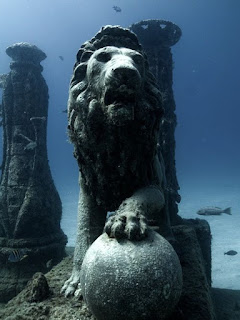 In ancient times, the port city of Thonis-Heracleion was the main port of entry to Egypt for all ships coming from the Greek world. | Heracleion, also known as Thonis, was an ancient Egyptian city near Alexandria whose ruins are located in Abu Qir Bay, 2.5 km off the coast, under 10m (30 ft) of water. Its beginnings go back as early as the 12th century BC. Its importance grew during the waning days of the Pharaohs — the late period, when it was Egypt's main port for international trade and collection of taxes. Heracleion was originally built on adjoining islands in the Nile Delta, and was intersected by canals. |  |
 | Heracleion flourished from the 6th to the 4th century BC. Pharaoh Nectanebo I made many additions to the temple there in the 4th century B.C. Much of the city sank in the 3rd or 2nd century AD, probably due to liquefaction of the silts on which it was built following earth tremors. Eventually it sunk entirely into the depths of the Mediterranean around the 8th century AD. The ruins submerged in the sea were located by the French underwater archaeologist Franck Goddio in 2000. |  |
 | The site spans 40 sq miles (110 sq km) with probably only 2% of the site excavated. More than 200 objects are showcased at an exhibition at Institut du Monde Arabe (The Arab World Institute) in Paris. |  |
  |   |   |
 |  |  |
  |   |   |

No comments:
Post a Comment